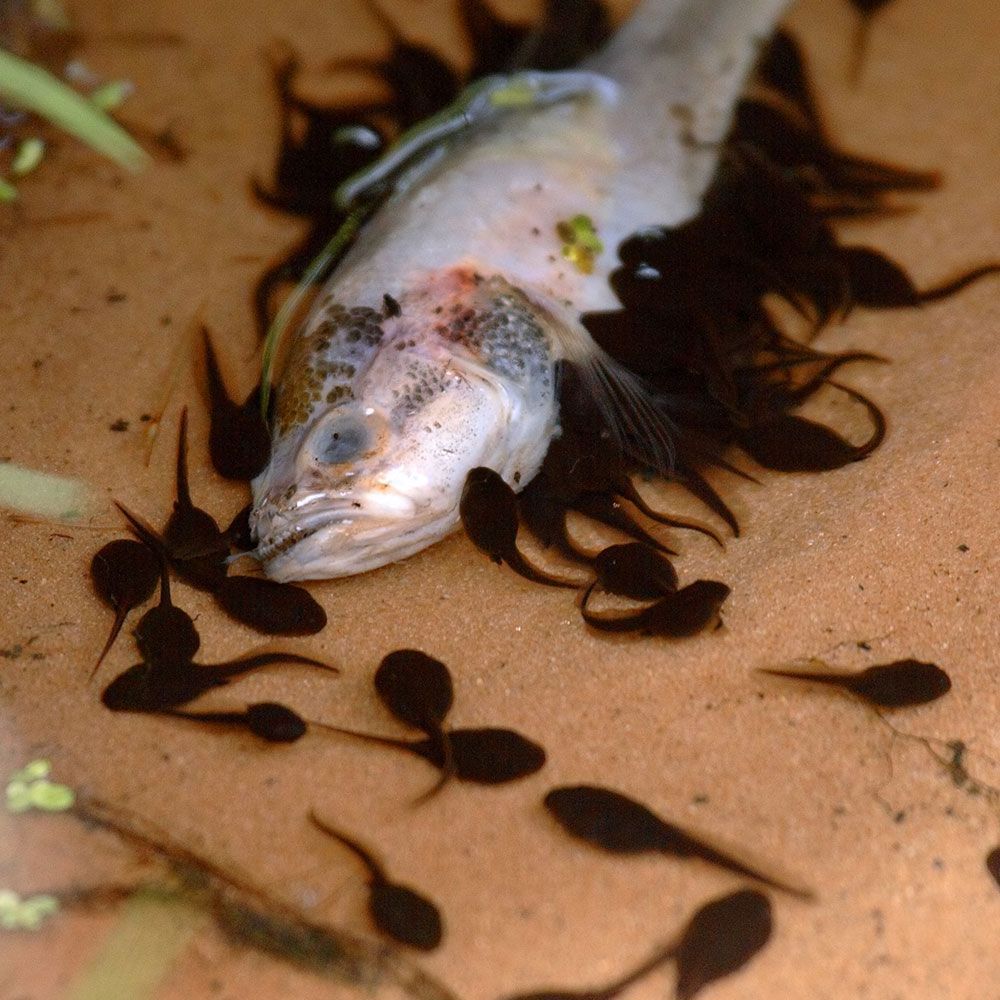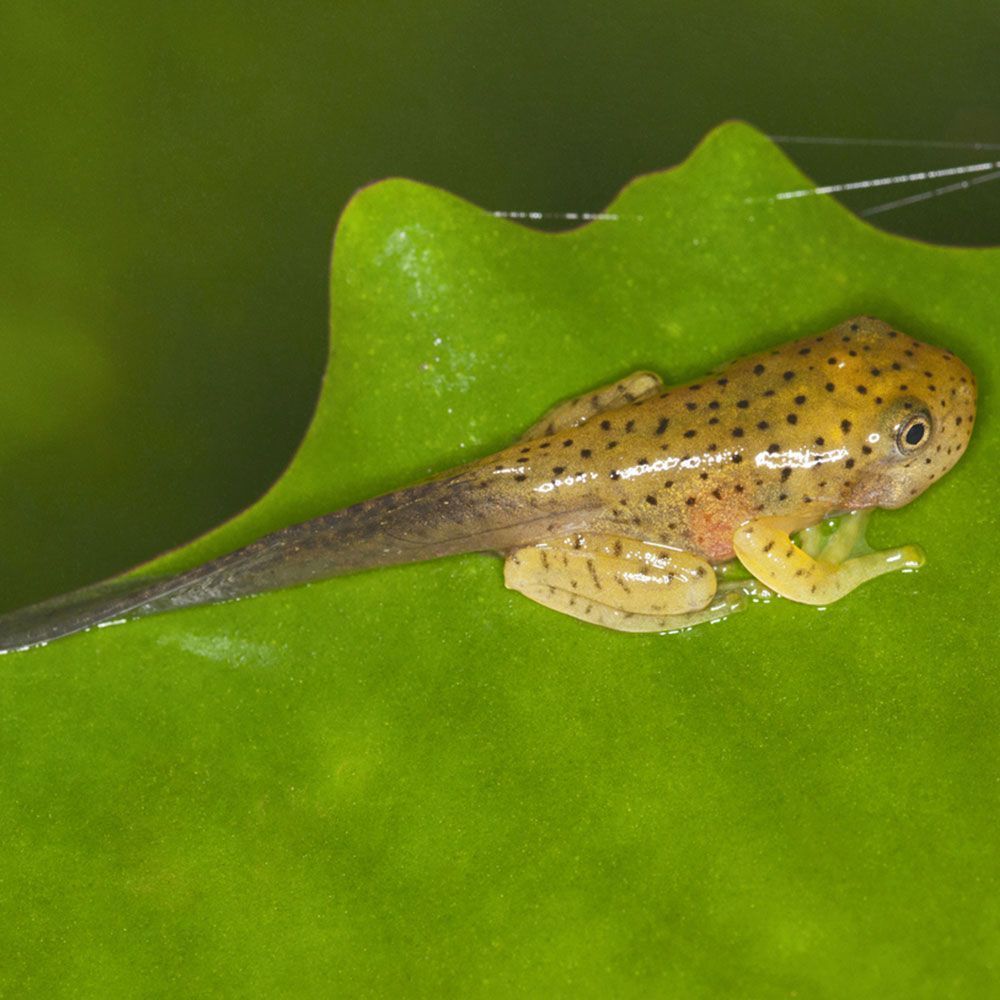In the wild and as pets, a young tadpole eats its own egg mass. As it grows a bit, it consumes a herbivorous diet of algae, plants, and leaves of pond weeds. They also eat baby spinach and soft lettuce. As they grow, they eat omnivorous feed, like insect larvae, small fish, and also commercial flakes in captivity.
Tadpoles are delightful little creatures who become graceful frogs as they grow. They don’t stay in this form forever. Their appetites and dietary preferences undergo fascinating changes as their life cycle progresses.
So, whether you are a nature enthusiast or want them to be delightful additions to your aquarium, this guide will shed light on their ever-changing diets. Keep reading…
What do tadpoles eat in the wild?
At the beginning of their journey, tadpoles feed on the protein-rich yolk sac from their own eggs in the wild.
When they outgrow this initial food source, they become herbivores and eat algae and surrounding aquatic plant matter in the pond, like duckweed and moss.
As they grow, their long intestinal tract shortens. It becomes specially designed to digest vegetation, enabling them to eat various foods, such as plants, leaves, moss, and small insects. This plant-based diet provides essential nutrients for their rapid growth and metamorphosis.
They embrace an omnivorous lifestyle as they grow, broadening their menu to include diverse food sources. They nibble on tougher plants and moss and eventually transition to consuming insects and mosquito larvae.
Since the food availability varies based on their environment, they can remarkably adapt by consuming whatever is available.
In the wild, they are opportunistic eaters. They consume almost anything available to sustain themselves. Their diet also includes duckweed, detritus, bacteria, protozoa, mosquito larvae, redworms, water striders, carcasses in the water, fish eggs, and even frog eggs.
In times of scarcity, they may resort to cannibalism and feed on each other.
Their diverse diet in the wild provides the essential nutrients they need for their growth and development. This prepares them to undergo their remarkable metamorphosis into agile frogs.
Their eating habits also contribute to the ecological balance of their aquatic ecosystems by controlling algae growth and regulating insect populations. As adaptable foragers, tadpoles play a crucial role in maintaining the delicate harmony of their natural habitats.
What is Foraging Behavior of Tadpoles?

The foraging behavior of tadpoles is influenced by the presence of predators.
Despite limited sight, they can distinguish colors and shapes and detect changes in light. With touch-sensitive neurons, basic sense of hearing, and sense of smell, they sense predators and locate food.
With a head-down orientation and skillful tail usage, they create wave-like movements, directing suspended food particles into their mouths.
They filter-feed on plankton and small organic matter from the water, scrape algae and aquatic vegetation from surfaces, and actively hunt small prey.
They actively feed during the early stages, but as they approach metamorphosis, hormonal changes lead to decreased feeding.
What to feed tadpoles as pets?
If you decide to keep tadpoles as pets, you must understand their dietary needs for every phase of life and maintain their health and development.
Early Life Diet: First Few Weeks
Newly Hatched
During the first few days after hatching, tadpoles mostly feed on their own egg sac yolk and the available algae in their tank or enclosure.
1-2 Weeks
At this age, introduce a variety of greens like lettuce, broccoli, baby spinach, green peas, zucchini, egg yolks, algae wafers, or small amounts of fish food or algae flakes. Lettuce or boiled cabbage provides essential calcium and protein for leg development.
Avoid feeding them romaine or iceberg lettuce, as these varieties lack sufficient nutrients.
2-4 Weeks
At this final stage of rapid growth, they shift towards eating more insects and insect larvae, reducing their intake of plant matter.
Continue offering small amounts of pellets, algae, and plant matter, and introduce brine shrimp flakes, bloodworms, and crickets.
Transition to Terrestrial Life
Once the amphibians develop their legs and become more terrestrial, they will need a standard frog diet, which is primarily carnivorous. The following foods are ideal for their growth during this transition:
- Algae
- Algae flakes
- Lettuce
- Broccoli
- Fish flakes
- Aphids
- Bloodworms
- Crickets
- Pellets
- Fruit flies
- Insect larvae
- Mealworms
What is the Feeding Frequency of Tadpoles?
To make sure your tadpoles can easily eat, it’s essential to prepare, chop, and boil the vegetables you offer them. This softens the food, making it more easy for them to consume. You can use a pair of tweezers or your fingers to put a pinch of the food into the water.
After placing the first pinch of food, observe your pet amphibian’s feeding behavior. If it consumes the initial offering, repeat the process until it stops eating.
Unfortunately, there’s no exact measurement for feeding amounts, as it depends on your pet’s age, species, and the type of food provided.
Well, these amphibians don’t usually overeat. But, to be safe, follow these:
- A tiny pinch per day is suitable for a week or two-old specimen.
- For older ones, don’t extend each feeding session more than 30 minutes once a day.
Create a feeding schedule to rotate between different types of vegetables and pellets. This will contribute to their overall health and well-being.
Note: If you notice excess food remaining in the tank an hour or two after feeding, it indicates overfeeding. Remove any uneaten food from the tank using a net. Otherwise, it can lead to water contamination and stress your pet.
What not to feed to tadpoles?
As a responsible caretaker of pet tadpoles, avoid this list of items from your pet’s diet:
1. Human Food & Other Pet Foods
Avoid human food like bread or food intended for other pets, such as cats, dogs, or turtle kibble. They can’t digest them and may be adversely affected.
2. Sugary Snacks
Avoid sugary snacks, processed foods like butter, or fruits like apples, strawberries, or pumpkins. Otherwise, it can disrupt their delicate digestive systems and cause potential health issues.
Never serve them fruits and vegetables with seeds or that have gone stale.
3. Wild-Caught Bugs or Meat
Insects found outdoors might carry diseases that can harm your pet amphibian. It’s best to rely on feeder insects from reputable pet stores to avoid such risks.
4. Wild Algae & Plants
Pet tadpoles might have less robust immune systems compared to their wild counterparts. So, wild-caught food could introduce parasites and diseases. Only feed wild-caught ones with edible aquatic plants like milfoil and pondweed.
How do tadpoles eat?
In their larval stage, tadpoles possess a unique feeding mechanism that differs significantly from the oral structure of adult frogs.
1. Mouth Structure
The oral disc of tadpoles has transverse rows of keratinized teeth, which helps in feeding. The teeth act as scraping tools and help suspend and capture food particles. The keratinized sheaths help in cutting and biting surfaces, enhancing ingestion.
As they grow, their oral morphology gradually transforms. Some possess structures that let them attach to substrates through suction, enhancing their feeding efficiency and survival.
2. Filter Feeding Process
Tadpoles, by filter feeding process, extract food particles from the water. In this, they pump water through their mouths and opercular chamber, where branchial filters and strands of mucus trap food particles. Some can even capture particles 0.126 μm from the water.
3. Unique Food Conservation
Tadpoles consume food at high rates and retain it in their guts for short periods and this sustains them for a while. They extract a small portion of the energy from ingested food.
4. Metamorphosis
During metamorphosis, they undergo drastic changes in both structure and function.
The mouth and digestive tract reorganize to shift from larval filter feeding to an adult carnivorous diet. The branchial apparatus plays a supportive role for the adult tongue.
Their growth rates and metamorphosis are highly variable and influenced by environmental factors like temperature, food availability, and population density.
Fast-growing specimens metamorphose earlier and at larger sizes compared to slow-growers.
A word from FishInAquarium
Tadpoles undergo a changing diet as they grow, beginning with plants and then transitioning to insects. So provide them with a regular balanced diet to help them grow into healthy frogs.
If you liked this guide, share it with fellow tadpole enthusiasts!
For further information, don’t hesitate to drop us an email. We’re here to help! Happy tadpole keeping!


